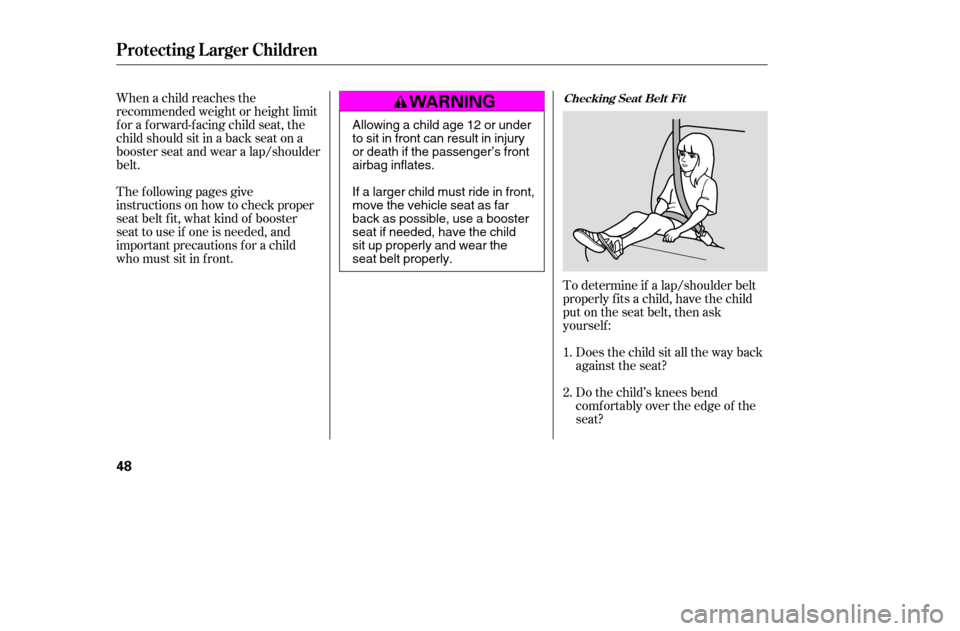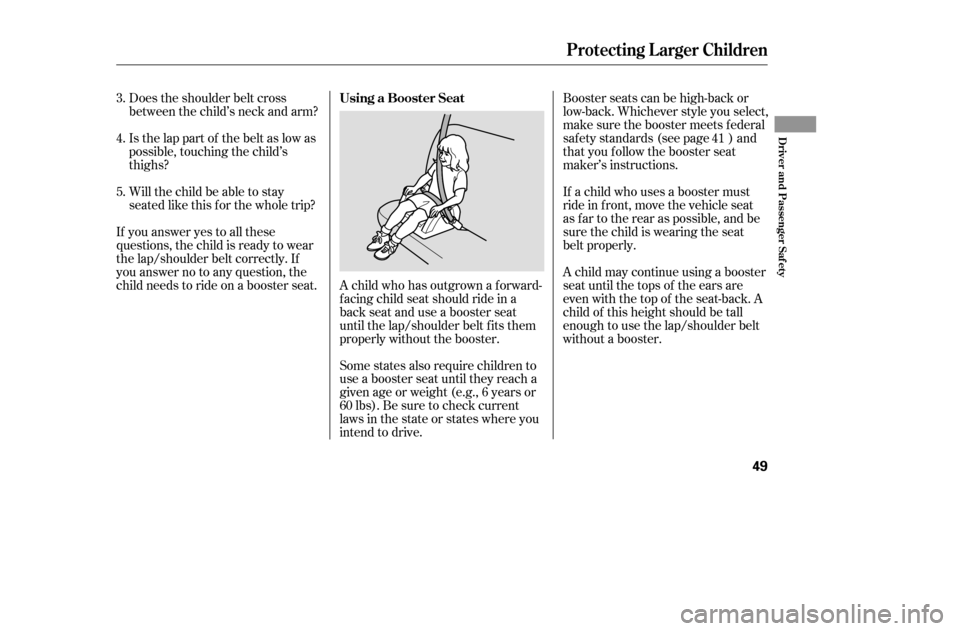Page 44 of 289

To determine if a lap/shoulder belt
properly f its a child, have the child
put on the seat belt, then ask
yourself :
When a child reaches the
recommended weight or height limit
for a forward-facing child seat, the
child should sit in a back seat on a
booster seat and wear a lap/shoulder
belt.
Does the child sit all the way back
against the seat?
Do the child’s knees bend
comf ortably over the edge of the
seat?
The f ollowing pages give
instructions on how to check proper
seat belt f it, what kind of booster
seat to use if one is needed, and
important precautions f or a child
who must sit in f ront.
1. 2.
Checking Seat Belt Fit
Protecting L arger Children
48
Allowing a child age 12 or under
to sit in front can result in injury
or death if the passenger’s front
airbag inflates.
If a larger child must ride in front,
move the vehicle seat as far
back as possible, use a booster
seat if needed, have the child
sit up properly and wear the
seat belt properly.
�����—�����—�����y�
�������������y���
�(�����������y�������
�y
Page 45 of 289

Does the shoulder belt cross
between the child’s neck and arm?
Is the lap part of the belt as low as
possible, touching the child’s
thighs?
Will the child be able to stay
seated like this f or the whole trip?
If you answer yes to all these
questions, the child is ready to wear
the lap/shoulder belt correctly. If
you answer no to any question, the
child needs to ride on a booster seat. A child who has outgrown a f orward- f acing child seat should ride in a
back seat and use a booster seat
until the lap/shoulder belt f its them
properly without the booster.
Some states also require children to
use a booster seat until they reach a
given age or weight (e.g., 6 years or
60 lbs). Be sure to check current
laws in the state or states where you
intend to drive.Booster seats can be high-back or
low-back. Whichever style you select,
make sure the booster meets f ederal
saf ety standards (see page ) and
that you f ollow the booster seat
maker’s instructions.
If a child who uses a booster must
ride in f ront, move the vehicle seat
as far to the rear as possible, and be
sure the child is wearing the seat
belt properly.
A child may continue using a booster
seat until the tops of the ears are
even with the top of the seat-back. A
child of this height should be tall
enough to use the lap/shoulder belt
without a booster.
4. 5.
3.
41
Protecting L arger Children
Using a Booster Seat
Driver and Passenger Saf ety
49
�����—�����—�����y�
������
������y���
�(�����������y���������y
Page 46 of 289

If you decide that a child can saf ely
ride up f ront, be sure to:Caref ully read the owner’s manual,
and make sure you understand all
seat belt instructions and all saf ety
inf ormation.
Move the vehicle seat to the rear-
most position.
Have the child sit up straight, back
against the seat, and feet on or
near the f loor.
Check that the child’s seat belt is
properly and securely positioned.
Supervise the child. Even mature
children sometimes need to be
reminded to f asten the seat belts
or sit properly.
Of course, children vary widely. And
while age may be one indicator of
when a child can saf ely ride in f ront,
there are other important f actors you
should consider.
If the passenger’s f ront airbag
inf lates in a moderate to severe
f rontal collision, the airbag can cause
serious injuries to a child who is
unrestrained, improperly restrained,
sitting too close to the airbag, or out
of position.
A side airbag also poses risks. If any
part of a larger child’s body is in the
path of a deploying side airbag, the
child could receive possibly serious
injuries.
The National Highway Traffic Safety
Administration and Transport
Canada recommend that all children
age 12 and under be properly
restrained in a back seat.
Physically, a child must be large
enough f or the lap/shoulder belt to
properly f it (see page ). If the seat
belt does not f it properly, with or
without the child sitting on a booster,
the child should not sit in f ront.
To saf ely ride in f ront, a child must
be able to f ollow the rules, including
sitting properly, and wearing the seat
belt properly throughout a ride.48
Protecting L arger Children
Physical Size
Maturity
When Can a L arger Child Sit in
Front
50
�����—�����—�����y�
������
��
���y���
�(�����������y���������y
Page 47 of 289
This could result
in serious neck injuries during a
crash. Devices intended to
improve a child’s comf ort or
reposition the shoulder part of a
seat belt can make the belt less
ef f ective and increase the chance
of serious injury in a crash.
This could
cause very serious injuries during
a crash. It also increases the
chance that the child will slide
under the belt in a crash and be
injured.
If they do, they
could be very seriously injured in a
crash.
Do not let a child wear a seat belt
across t he neck. Do not put any accessories on a
seat belt .
Do not let a child put the shoulder part of a seat belt behind t he backor under t he arm.
T wo children should never use t hesame seat belt .
Additional Saf ety Precautions
Protecting L arger Children
Driver and Passenger Saf ety
51
�����—�����—�����y�
������
������y���
�(�����������y���������y
Page 52 of 289
The U.S. instrument panel is shown. Dif f erences f or the Canadian models are noted in thetext.
Instrument Panel
Inst rument s and Cont rols
57
CRUISE CONTROL INDICATOR
LOW FUEL INDICATOR MAINTENANCE REQUIRED
INDICATOR
MALFUNCTION
INDICATOR LAMP TRACTION CONTROL SYSTEM
INDICATOR
PARKING BRAKE AND BRAKE
SYSTEM INDICATOR TCS ACTIVATION INDICATOR
LOW OIL PRESSURE
INDICATOR
CHARGING SYSTEM
INDICATOR
SECURITY SYSTEM INDICATOR
IMMOBILIZER SYSTEM INDICATOR
ANTI-LOCK BRAKE SYSTEM
(ABS) INDICATOR
SUPPLEMENTAL
RESTRAINT SYSTEM
INDICATOR
DOOR AND TRUNK
OPEN MONITOR
CRUISE CONTROL MAIN
INDICATOR
LIGHTS ON INDICATOR
HIGH BEAM INDICATOR
(P.70)
(P.58)
(P.58)
(P.58) (P.58)(P.61)
(P.61)
SEAT BELT REMINDER LIGHT (P.58) (P.62)
(P.59)
(P.59)
SIDE AIRBAG OFF
INDICATOR
(P.60)(P.63)
(P.60) (P.63)
(P.60)
(P.59)
(P.63) (P.62)
�����—�����—�����y�
�������������y���
�(�����������y���������y
Page 53 of 289

The instrument panel has many
indicators to give you important
inf ormation about your vehicle.If this indicator comes on when the
engine is running, the battery is not
being charged. For more inf ormation,
see page .
See page .This indicator has two f unctions:
This indicator comes on when you
turn the ignition switch to ON (II). It
reminds you and your passengers to
f asten your seat belts. A beeper also
sounds if you have not f astened your
seat belt.
If you turn the ignition switch to ON
(II) bef ore f astening your seat belt,
the beeper sounds and the indicator
f lashes. If you do not f asten your
seat belt bef ore the beeper stops, the
indicator stops f lashing but remainson.
If you continue driving without
f astening your seat belt, the beeper
sounds and the indicator f lashes
again at regular intervals. Itcomesonwhenyouturnthe
ignition switch to ON (II). It is a
reminder to check the parking
brake. A beeper sounds if you try
to drive with the parking brake not
f ully released. Driving with the
parking brake not f ully released
can damage the brakes and tires.
If it remains lit af ter you f ully
release the parking brake while
the engine is running, or if it
comes on while driving, there
could be a problem with the brake
system. For more inf ormation, see
page .
The engine can be severely damaged
if this indicator f lashes or stays on
when the engine is running. For
more inf ormation, see page .
1. 2.
258
259 259
261
Instrument Panel L ights
Seat Belt Reminder L ight L ow Oil Pressure
Indicator
Charging System
Indicator
Malf unction Indicator
LampParking Brake and Brake
System Indicator
58
U.S. Canada
�����—�����—�����y�
�������������y���
�(�����������y�������
�y
Page 54 of 289

This indicator comes on brief ly when
you turn the ignition switch to ON
(II). If it comes on at any other time,
it indicates a potential problem with
your f ront airbags. This indicator will
also alert you to a potential problem
with your side airbags, passenger’s
side airbag automatic cutoff system,
side curtain airbags, automatic seat
belt tensioners, driver’s seat position
sensor, or the f ront passenger’s
weight sensors. For more
inf ormation, see page .This indicator normally comes on f or
a f ew seconds when you turn the
ignition switch to ON (II), and when
the ignition switch is turned to
START (III). If it comes on at any
other time, there is a problem with
theABS.If thishappens,haveyour
vehicle checked at a dealer. With
this on, your vehicle still has normal
braking ability but no anti-lock
brakes. For more inf ormation, see
page .
This indicator comes on when you
turn the ignition switch to ON (II). If
it comes on at any other time, it
indicates that the passenger’s side
airbag has automatically shut off.
For more inf ormation, see page .
30 186
31
Instrument Panel L ights
Supplemental Restraint
System Indicator
Anti-lock Brake System
(A BS) Indicator
Side A irbag Of f
Indicator
Inst rument s and Cont rols
59
U.S. Canada
�����—�����—���
�y�
����
��������y���
�(�����������y���������y
Page 86 of 289
Theyaremosteffectivewhenyou
adjust them so the back of the
occupant’s head rests against the
center of the restraint.
The f ront and rear head restraints
adjust f or height. You need both
hands to adjust the restraint. Do not
attempt to adjust it while driving. To
raise it, pull upward. To lower the
restraint, push the release button
and push the restraint down.The back of the rear seat folds down,
giving you direct access to the trunk.
The seat-back can be released f rom
inside the vehicle or inside the trunk.When storing cargo, you can move
therearcentershoulderbeltoutof
the way by removing the belt f rom
the guide.
To fold down the seat-back from
inside the vehicle, insert the master
keyinthelockontherearshelf.
Turn the key clockwise, pull down
the top of the seat-back, then release
the key.
Folding Rear Seat
Seats
Inst rument s and Cont rols
91
MASTER KEY
GUIDE
�����—�����—�����y�
�������������y���
�(�����������y���������y